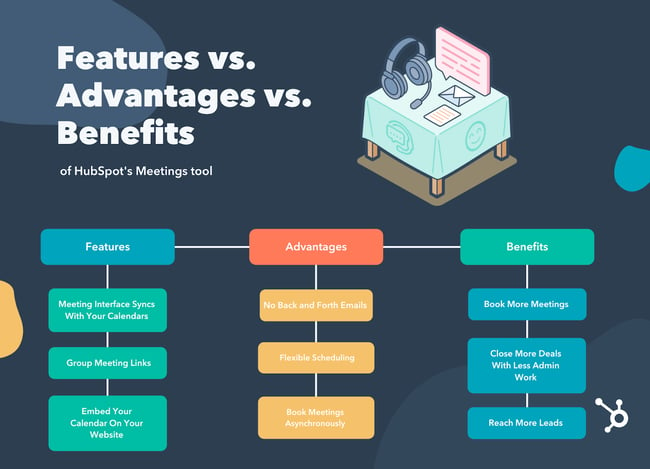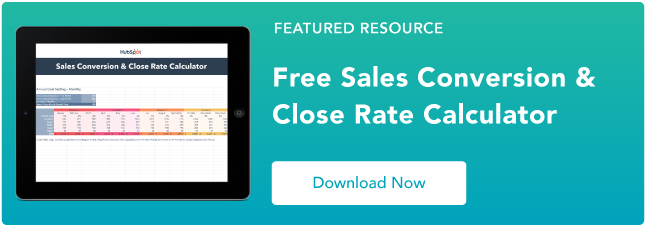Salespeople are often told to sell benefits, not just features. But the distinction can sometimes feel blurry. Is the product’s ability to scale with a prospect’s growth a feature or a benefit? What about its best-in-class quality? Or its ease of use?
Understanding the difference between features, advantages, and benefits is crucial to a rep’s success. A truly holistic approach to selling means conveying all three of these elements to prove the business’s value to prospects.
For a deeper understanding of features, advantages, and benefits, take a look at this video by Adam Erhart.
Examples of Features, Advantages, and Benefits
Using HubSpot’s Meetings tool as an example, here’s how to break down features, advantages, and benefits.

- Example Feature – HubSpot’s Meetings tool provides an interface that is synced to your Google or Office 365 calendar.
- Example Advantage – Prospects select the meeting time that works for them without back and forth email communication.
- Example Benefit – You’ll be able to reach more leads, book more meetings, and close more deals with less admin work.
Next, let’s take a dive into features vs. benefits to better understand the difference.
Feature-Benefit Selling Examples
Here are two few feature-benefit examples that appeals to customers with different needs.
Feature: “Our platform automatically records your meetings. The editing tools make it easy to remove background noise, clip unnecessary sections, and flag key sections of the recording. Once you’ve finished editing, you can send the file to all the meeting attendees with one click.”
Benefit for Buyer #1: “Since your company values transparency, I’d like to show you our recording feature. Every meeting is automatically recorded. At the end of your day, it’ll take two seconds to send the audio files to each group of attendees and upload them to your company server. Everyone on your team will have full clarity into your meetings.”
Benefit for Buyer #2: “You’ve mentioned how much time you spend after every meeting writing a summary for your stakeholders. With our platform, you can get almost all that time back. Every meeting is recorded. You can send the audio file as is, or easily clean it up, cut it down, or call out important sections, with our editing tools. The entire process will take 5 minutes rather than half an hour.”
Both of the benefits described show an emotional significance that’s tied to the specific feature. During the qualification process, you’ll get to know your prospect’s pains intimately, so part of the challenge will be mapping those features into benefits to drive the point home.
You can do that by identifying advantages, which bridge the gap between features and benefits (more on that later). However, the distinction between advantages and benefits is trickier.
In essence, advantages are why the features matter, and benefits are why the advantages matter.
Because features are the nuts and bolts of the thing and people make decisions based on emotion, selling on features alone is not enough.
It’s the benefits that convince them to buy.
How to Sell Benefits Rather Than Features
Reps cannot properly explain their product’s benefits without knowing their buyer’s goals, challenges, and desires. As the above example shows, what appeals to one prospect might not resonate with another.
Asking the right discovery questions is necessary but not sufficient. Once salespeople have properly assessed their prospect’s situation, they must map each feature to their prospect’s needs. The link between capability and problem or desire turns a feature into a benefit.
It may be helpful for reps to ask themselves, “So what?”
For example, let’s say a salesperson is pitching her user research firm’s services to the head of product at a startup.
Her original statement might be: “We handle every stage of the user research process, from finding participants and designing questions to analyzing the results and creating a report.”
She asks herself, “So what?”
That question leads the salesperson to add: “You’ve mentioned how quickly your team needs to move. By outsourcing the user research process, you can take products from idea to launch at least two weeks faster — which will give you a huge competitive advantage.”
Answering the silent “So what?” in their explanation forces salespeople to personalize their messaging.
When explaining benefits, quality beats quantity.
Salespeople are often tempted to explain every feature of their product. Yes, prospects want to get their money’s worth — but they usually don’t equate more features with higher value.
When a rep throws the kitchen sink at the buyer, two things happen. First, the buyer feels like the salesperson doesn’t truly “get” him or his situation. He’s invested time and energy into answering the rep’s questions, so why is he getting a one-size-fits-all explanation?
Second, the salesperson inadvertently deemphasizes the details that truly matter to her prospect. If she spends five minutes on two points, she can highlight why those items are so important. Yet if she spends that same five minutes on four points, she can’t explore them to the same degree. Rather than learning about two things that really interest him, the buyer gets a rushed discussion of two things that interest him and two things he doesn’t care about.
The takeaway? To successfully sell benefits, salespeople must leave out the information that doesn’t pertain to their prospects. Before they provide a new detail, they should ask themselves, “Will this aspect of the product help the buyer achieve their goals or alleviate their pain?” If the answer is no, they should skip it.
Selling the Sizzle, Not the Steak
Famous salesman Elmer Wheeler, coined the phrase “sell the sizzle, not the steak” in the 1920s. More than 100 years later, that phrase still applies. What Wheeler meant by this is that the sizzle is just as enticing, if not more so, than the steak itself because it contributes to the experience and emotion that comes with eating a steak.
Said in today’s terms, prospects won’t typically make a purchase unless they can see how the product will improve their lives. The purchase should solve a pain point for the customer that makes their overall experience better. To bring this old saying to life, reps should focus on selling benefits instead of features.
Editor’s note: This post was originally published in October 2016 and has been updated for comprehensiveness.

![]()


![Read more about the article How to Use BANT to Qualify Prospects in 2024 [Expert Tips]](https://www.dimaservices.agency/wp-content/uploads/2024/04/e97d6603-b40e-4085-ad55-0074b7351ead-1-300x30.png)
